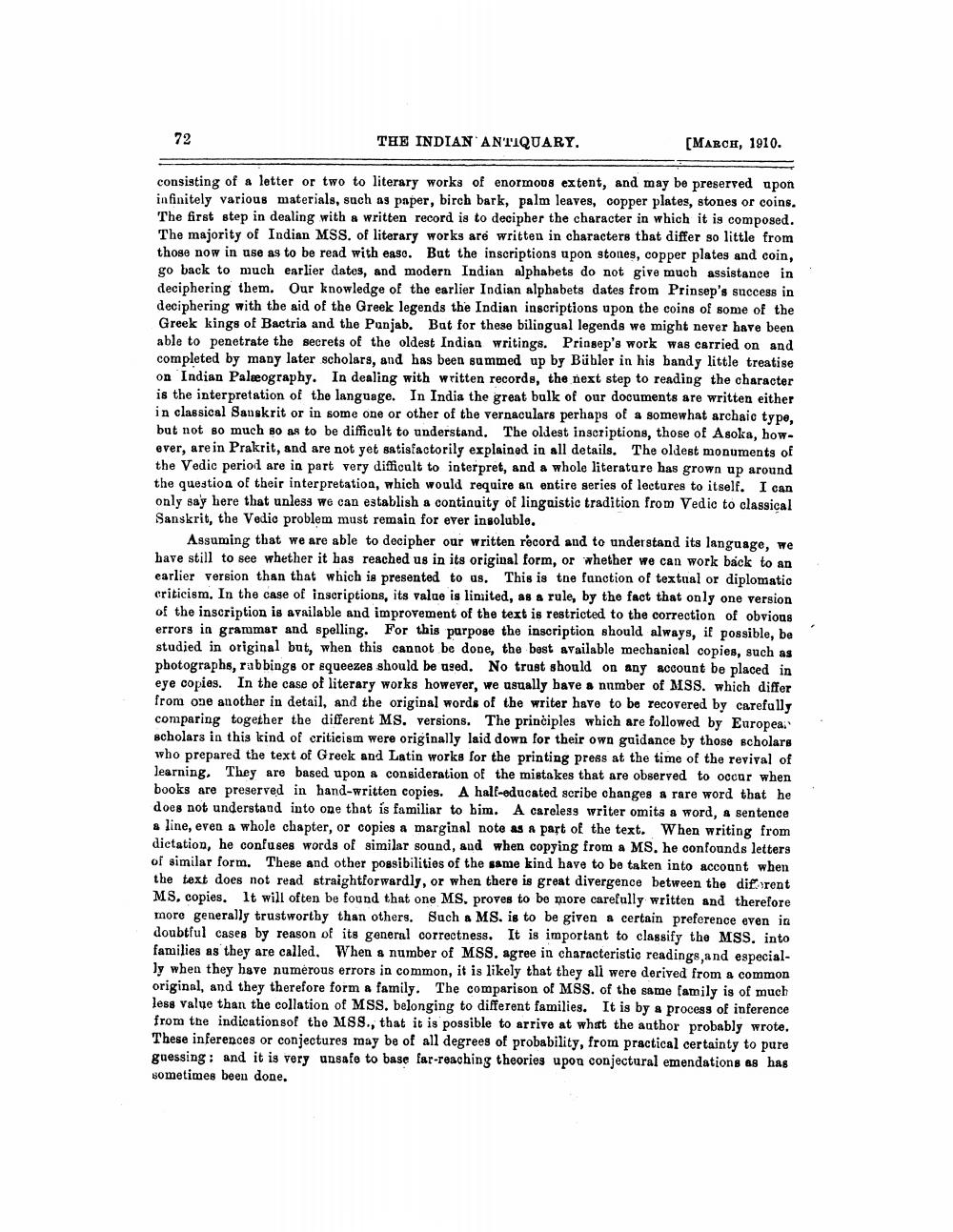________________
72
THE INDIAN ANTIQUARY.
[MARCH, 1910.
consisting of a letter or two to literary works of enormous extent, and may be preserved upon infinitely various materials, such as paper, birch bark, palm leaves, copper plates, stones or coins. The first step in dealing with a written record is to decipher the character in which it is composed. The majority of Indian MSS. of literary works are written in characters that differ so little from those now in use as to be read with ease. But the inscriptions upon stones, copper plates and coin, go back to much earlier dates, and modern Indian alphabets do not give much assistance in deciphering them. Our knowledge of the earlier Indian alphabets dates from Prinsep's success in deciphering with the aid of the Greek legends the Indian inscriptions upon the coins of some of the Greek kings of Bactria and the Punjab. But for these bilingual legends we might never have been able to penetrate the secrets of the oldest Indian writings. Prinsep's work was carried on and completed by many later scholars, and has been summed up by Bühler in his handy little treatise on Indian Palæography. In dealing with written records, the next step to reading the character is the interpretation of the language. In India the great bulk of our documents are written either in classical Sanskrit or in some one or other of the vernaculars perhaps of a somewhat archaic type, but not so much so as to be difficult to understand. The oldest inscriptions, those of Asoka, however, are in Prakrit, and are not yet satisfactorily explained in all details. The oldest monuments of the Vedic period are in part very difficult to interpret, and a whole literature has grown up around the question of their interpretation, which would require an entire series of lectures to itself. I can only say here that unless we can establish a continuity of linguistic tradition from Vedic to classical Sanskrit, the Vedic problem must remain for ever insoluble.
Assuming that we are able to decipher our written record and to understand its language, we have still to see whether it has reached us in its original form, or whether we can work back to an earlier version than that which is presented to us. This is the function of textual or diplomatic criticism. In the case of inscriptions, its value is limited, as a rule, by the fact that only one version of the inscription is available and improvement of the text is restricted to the correction of obvious errors in grammar and spelling. For this purpose the inscription should always, if possible, be studied in original but, when this cannot be done, the best available mechanical copies, such as photographs, rabbings or squeezes should be used. No trust should on any account be placed in eye copies. In the case of literary works however, we usually have a number of MSS. which differ from one another in detail, and the original words of the writer have to be recovered by carefully comparing together the different MS. versions. The principles which are followed by Europea. scholars in this kind of criticism were originally laid down for their own guidance by those scholars who prepared the text of Greek and Latin works for the printing press at the time of the revival of learning. They are based upon a consideration of the mistakes that are observed to occur when books are preserved in hand-written copies. A half-educated scribe changes a rare word that he does not understand into one that is familiar to him. A careless writer omits a word, a sentence a line, even a whole chapter, or copies a marginal note as a part of the text. When writing from dictation, he confuses words of similar sound, and when copying from a MS. he confounds letters of similar form. These and other possibilities of the same kind have to be taken into account when the text does not read straightforwardly, or when there is great divergence between the diferent MS, copies. It will often be found that one MS. proves to be more carefully written and therefore more generally trustworthy than others. Such a MS. is to be given a certain preference even in doubtful cases by reason of its general correctness. It is important to classify the MSS. into families as they are called. When a number of MSS. agree in characteristic readings, and especially when they have numerous errors in common, it is likely that they all were derived from a common original, and they therefore form a family. The comparison of MSS. of the same family is of much less value than the collation of MSS. belonging to different families. It is by a process of inference from the indicationsof the MSS., that it is possible to arrive at what the author probably wrote. These inferences or conjectures may be of all degrees of probability, from practical certainty to pure guessing and it is very unsafe to base far-reaching theories upon conjectural emendations as has sometimes been done.
:




